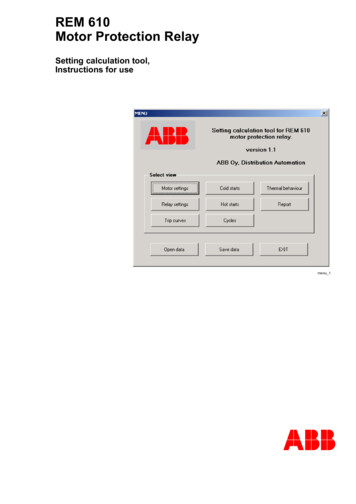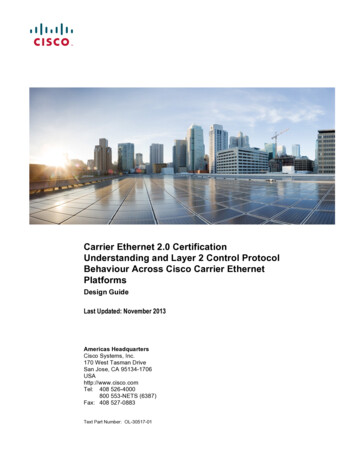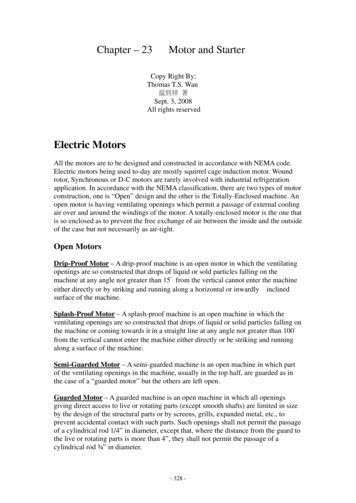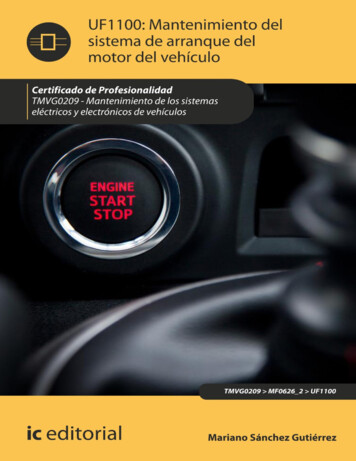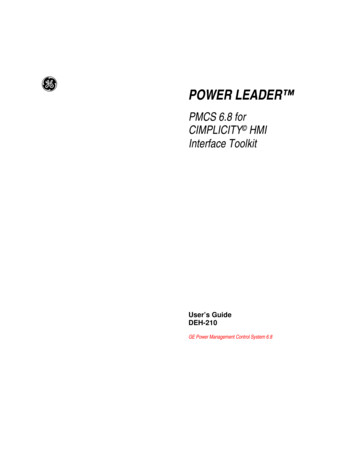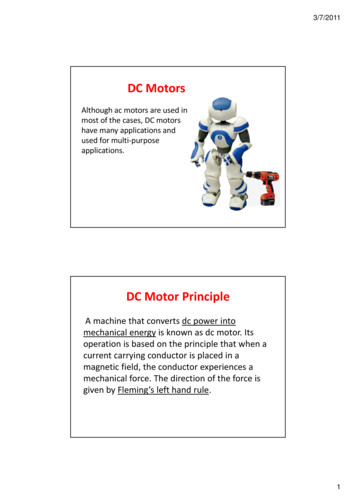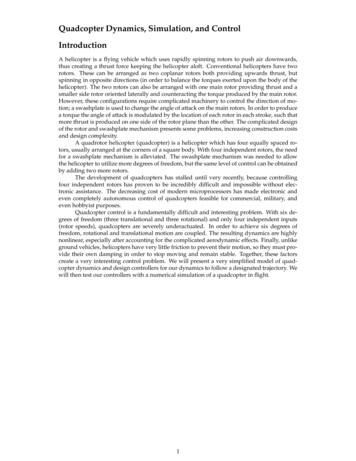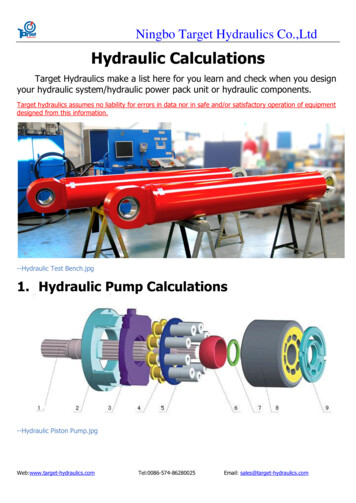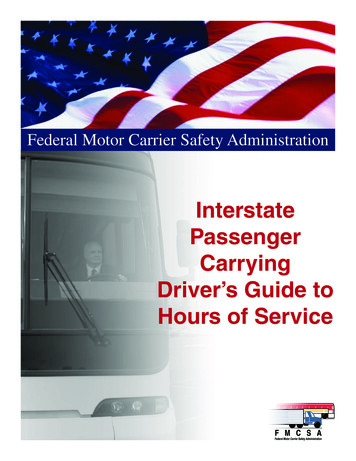
Transcription
Federal Motor Carrier Safety s Guide toHours of Service
Interstate Passenger Carrying Driver’s Guide toHours of ServiceTable of ContentsWhat Are the Hours-of-Service Regulations? . . . . . . . . . . . . . . . . . . . . . . . . . . . . . . . . . . . . . . . . 1Who Must Comply With the Hours-of-Service Regulations? . . . . . . . . . . . . . . . . . . . . . . . . . . . . 1Interstate/Intrastate Commerce . . . . . . . . . . . . . . . . . . . . . . . . . . . . . . . . . . . . . . . . . . . . . . . . . 2Personal Use of a Commercial Motor Vehicle . . . . . . . . . . . . . . . . . . . . . . . . . . . . . . . . . . . . . 3Weight Ratings . . . . . . . . . . . . . . . . . . . . . . . . . . . . . . . . . . . . . . . . . . . . . . . . . . . . . . . . . . . . . 3Designed or Used . . . . . . . . . . . . . . . . . . . . . . . . . . . . . . . . . . . . . . . . . . . . . . . . . . . . . . . . . . . 3Air Miles and Statute Miles . . . . . . . . . . . . . . . . . . . . . . . . . . . . . . . . . . . . . . . . . . . . . . . . . . . 3What Are the Hours-of-Service Limits? . . . . . . . . . . . . . . . . . . . . . . . . . . . . . . . . . . . . . . . . . . . . . 415-Hour On-Duty Limit . . . . . . . . . . . . . . . . . . . . . . . . . . . . . . . . . . . . . . . . . . . . . . . . . . . . . . 410-Hour Driving Limit . . . . . . . . . . . . . . . . . . . . . . . . . . . . . . . . . . . . . . . . . . . . . . . . . . . . . . . 460/70-Hour Duty Limit . . . . . . . . . . . . . . . . . . . . . . . . . . . . . . . . . . . . . . . . . . . . . . . . . . . . . . . 5What Is On-Duty Time? . . . . . . . . . . . . . . . . . . . . . . . . . . . . . . . . . . . . . . . . . . . . . . . . . . . . . . . . . 6What Is Off-Duty Time?. . . . . . . . . . . . . . . . . . . . . . . . . . . . . . . . . . . . . . . . . . . . . . . . . . . . . . . . . 7What Is the Adverse Driving Conditions Exception?. . . . . . . . . . . . . . . . . . . . . . . . . . . . . . . . . . . 7Exceptions From the Hours-of-Service Regulations . . . . . . . . . . . . . . . . . . . . . . . . . . . . . . . . . . . 8How Does the Sleeper Berth Provision Work? . . . . . . . . . . . . . . . . . . . . . . . . . . . . . . . . . . . . . . . 9What Is a “Driver’s Daily Log”? . . . . . . . . . . . . . . . . . . . . . . . . . . . . . . . . . . . . . . . . . . . . . . . . . . 9Who Must Complete a Log? . . . . . . . . . . . . . . . . . . . . . . . . . . . . . . . . . . . . . . . . . . . . . . . . . . . . . 10What Are the Exceptions From the Logging Requirements? . . . . . . . . . . . . . . . . . . . . . . . . . . . . 10100 Air-Mile Radius . . . . . . . . . . . . . . . . . . . . . . . . . . . . . . . . . . . . . . . . . . . . . . . . . . . . . . . 10Private motor carrier of passengers (non-business) . . . . . . . . . . . . . . . . . . . . . . . . . . . . . . . . 10What Must the Log Include? . . . . . . . . . . . . . . . . . . . . . . . . . . . . . . . . . . . . . . . . . . . . . . . . . . . . 11The Graph Grid . . . . . . . . . . . . . . . . . . . . . . . . . . . . . . . . . . . . . . . . . . . . . . . . . . . . . . . . . . . . 12The “Remarks” . . . . . . . . . . . . . . . . . . . . . . . . . . . . . . . . . . . . . . . . . . . . . . . . . . . . . . . . . . . . 13A Completed Grid . . . . . . . . . . . . . . . . . . . . . . . . . . . . . . . . . . . . . . . . . . . . . . . . . . . . . . . . . 13A Completed Log . . . . . . . . . . . . . . . . . . . . . . . . . . . . . . . . . . . . . . . . . . . . . . . . . . . . . . . . . . 14What Is an Automatic On-Board Recording Device?. . . . . . . . . . . . . . . . . . . . . . . . . . . . . . . . . . 15
Interstate Passenger Carrying Driver’s Guide to Hours of ServiceWhat Are the Hours-of-Service Regulations?As the driver of a bus, motorcoach, or other passengercarrying vehicle, you have a lot of responsibility as youdrive down the road. The biggest concern is safety. Thatbrings us to the main reason for the hours-of-serviceregulations — to keep fatigued drivers off the publicroadways. These regulations put limits in place forwhen and how long you may drive, with the idea thatthese limits will help make sure that you stay awake andalert while driving.The hours-of-service regulations are found in Part 395of the Federal Motor Carrier Safety Regulations. Theseregulations are developed and enforced by the FederalMotor Carrier Safety Administration, which is part ofthe United States Department of Transportation. (Statesmay have identical or similar regulations, as we willexplain later.)Who Must Comply With the Hours-of-Service Regulations?You must follow the hours-of-service regulations if you drive a commercial motor vehicle. Justwhat is a commercial motor vehicle?In general, for purposes of this document, it is a bus, motorcoach, or other passenger-carryingvehicle that: Is involved in interstate commerce and weighs (including any passengers and cargo) 10,001pounds (4,536 kg) or more. Is involved in interstate commerce and has a gross vehicle weight rating or gross combination weight rating of 10,001 pounds (4,536 kg) or more. Is involved in interstate commerce and is designed or used to transport 9 or more passengers(including the driver) for compensation. Is involved in interstate commerce and is designed or used to transport 16 or more passengers (including the driver) not for compensation. Is involved in interstate or intrastate commerce and is transporting hazardous materials in aquantity requiring placards.We will describe these terms in greater detail in the next sections of this document.**NOTE** There are exceptions to certain hours-of-service requirements for some operations.These will be covered later.**NOTE** Be aware that we are only talking here about the hours-of-service regulations. Forother areas of regulation, the definition of commercial motor vehicle will vary, for example drugand alcohol regulations and commercial driver’s license (CDL) requirements.1
Interstate Passenger Carrying Driver’s Guide to Hours of ServiceInterstate/Intrastate CommerceTo help you understand the definition of a commercial motor vehicle, let’s talk about the meanings of interstate commerce and intrastate commerce. Commerce deals with buying and sellinggoods and services. It also deals with moving goods or passengers from place to place or goingsomewhere to perform services. Basically any work done in support of a business is considered tobe commerce.Interstate commerce means the goods or passengers have traveled into or through another State or country or someone has goneinto another State or country to perform the service. Even if yourvehicle does not leave your State, but the goods or passengers haveor will, the transportation is usually considered to be in interstatecommerce.If you operate in interstate commerce once in a while, you are not required to comply with theFederal hours-of-service regulations all of the time. You must follow the Federal hours-of-serviceregulations while you are operating in interstate commerce. At the point you start driving in interstate commerce you must have logs with you for your last 7 days (unless you were not required tolog).You must also follow the Federal hours-of-service regulations for a short period of time after youfinish operating in interstate commerce. If you were using the 60-hour/7-day schedule, you mustfollow the Federal hours-of-service regulations for the next 7 days after you finish operating ininterstate commerce. If you were using the 70-hour/8-day schedule, you must follow the Federalhours-of-service regulations for the next 8 days after you finish operating in interstate commerce.Intrastate commerce means the goods, passengers, and/or services stay within a single State;they do not leave their State.If you are operating in intrastate commerce only (and are not carrying hazardous materials requiring a placard), the Federal regulations do not apply to you. However, most States have regulationsthat are similar or identical to the Federal regulations. To determine what State safety requirements you must follow, you should contact the appropriate State agency. This is usually the Statepolice, highway patrol, or an office within the State’s department of transportation.Sometimes your vehicle may be empty. In these cases your vehicle is still considered to be incommerce because it is being used to support a business. Even if it is empty, you are considered tobe operating in interstate commerce if you go outside of your State. If the vehicle is empty andyou are operating inside your State, you are operating in intrastate commerce.2
Interstate Passenger Carrying Driver’s Guide to Hours of ServicePersonal Use of a Commercial Motor VehicleIt is possible that occasionally you may not use a passenger-carrying vehicle in commerce at all. You may be transporting yourfriends or family or moving your personal belongings or, as ahobby, you may be towing a horse or car to a show. As long asthe activity is not in support of a business, you are not operatingin commerce.If you are not operating your vehicle in commerce, you are notsubject to the hours-of-service regulations.Weight RatingsIn part, a passenger-carrying vehicle can be a commercial motorvehicle based on what it actually weighs or on what its weightrating is, whichever is greater.To find the gross vehicle weight rating of a passenger-carryingvehicle, look for a manufacturer’s plate on the vehicle. In some models, the plate might be insidethe glove box. To find the gross weight rating of a towed unit, look for a plate on the front of thetrailer. If the trailer has a tongue, the plate might be on the tongue of the trailer.Your vehicle may have a gross combination weight rating posted in the same manner as thegross vehicle weight rating. If it does not, to figure the gross combination weight rating add thegross vehicle weight rating of the power unit and the actual weight of the trailer and its load.Designed or UsedA passenger-carrying vehicle can also be a commercial motor vehicle based on how many passengers it carries or was designed to carry, whichever is greater. For example, if you never transportmore than 8 passengers on your bus, but that bus was designed to transport 18 passengers, thenthat bus is considered a commercial motor vehicle.“Designed to carry” refers to the number of designated seats as originally designed. Even if youremove some seats, whether temporarily or permanently, you have not changed the number ofpassengers the vehicle was originally designed to carry.If, however, you remove all the seats from a passenger-carrying vehicle and convert it to a cargocarrying vehicle, then it would be considered a property-carrying vehicle and you would have tofollow different hours-of-service rules.Finally, note that “designed to carry” does not include areas suitable, or even designed, for standing passengers.Air Miles and Statute MilesIn the discussion of exceptions to the logging requirement, you will see the term “air miles.” Thisis a different measurement of a mile than what is used for statute miles on a roadmap. An air mileis longer than a statute mile. There are 6,076 feet in an air mile and 5,280 feet in a statute mile.One-hundred air miles is equal to 115.08 statute miles.Therefore, a 100 air-mile radius from your work reporting location can be figured as 115.08 statute, or “roadmap,” miles (185.2 km) from your work reporting location.3
Interstate Passenger Carrying Driver’s Guide to Hours of ServiceWhat Are the Hours-of-Service Limits?The hours-of-service regulations focus on when and how long youare allowed to drive by placing specific limits on the amount of timeyou drive your commercial motor vehicle and how many total hoursyou can work before you are no longer permitted to drive. You mustfollow three maximum duty limits at all times. They are the 15-houron-duty limit, 10-hour driving limit, and 60/70-hour duty limit.15-Hour On-Duty LimitThe first limit is the 15-hour on-duty limit. Following 8 consecutive hours off duty, you must not drive a commercial motor vehicleafter being on duty 15 hours. You may do other work after being onduty 15 hours, but you may not drive.Off-duty time taken during the day, such as a lunch break or nap,does not count toward this 15-hour limit. Also, if you have a sleeper berth in your vehicle, youmay be able to use it to get the required rest and to extend the 15-hour limit. Sleeper berth provisions will be discussed later in this section.Example: You have had 8 continuous hours off and you come to work at 6:00 a.m. You workfor 7 hours, take one hour off for lunch, and work another 8 hours until 10:00 p.m., for a total of15 on-duty hours. You must not drive a commercial motor vehicle after 10:00 p.m. that evening.You may do other work after 10:00 p.m., but you can not do any more driving until you havetaken another 8 consecutive hours off.This regulation is found in Section 395.5(a)(2).10-Hour Driving LimitThe second limit is the driving limit. You are allowed 10 hours of driving time after 8 consecutivehours off duty. There is no limit on how many of thosehours you are allowed to drive at one time — you maydrive for as little as a few minutes or as much as 10hours in a row. Once you have driven a total of 10hours, you have reached the driving limit and must beoff duty for another 8 consecutive hours before drivinga commercial motor vehicle again.The 8 consecutive hours may consist of off duty, sleeperberth, or any combination of the two. There must be noon-duty or driving time during those 8 hours.Example: You have had 8 consecutive hours off. You come to work at 7:00 a.m. and drive from8:00 a.m. until 6:00 p.m., You must not drive again until you have at least 8 consecutive hoursoff. You may do other work after 6:00 p.m., but you can not do any more driving of a commercial motor vehicle.4
Interstate Passenger Carrying Driver’s Guide to Hours of ServiceThis regulation is found in Section 395.5(a)(1).60/70-Hour Duty LimitIn addition to the limits explained above, there is the 60/70-hourlimit. This limit is based on a 7-day or 8-day period, starting atthe time specified by your company for the start of a 24-hourperiod.DAY1. SundayHOURS02. Monday103. Tuesday8.54. Wednesday12.5This limit is sometimes thought of as a “weekly” limit. However, 5. Thursday9this limit is not based on a “set” week, such as Sunday through 6. Friday10Saturday. The limit is based on a “rolling” or “floating” 7-day or 7. Saturday128-day period. The oldest day’s hours drop off at the end of each 8. Sunday5day when you calculate the total on-duty time for the past 7 or 8 TOTAL67 hoursdays. For example, if you operate on a 70-hour/8-day schedule,the current day would be the newest day of your 8-day period and the hours you worked 9 daysago would drop out of the calculation.You are required to follow one of these two “weekly” limits: If your company does not operate vehicles every day of the week, you are not allowed todrive after you’ve been on duty 60 hours during any 7 consecutive days. Once you reach the60-hour limit, you will not be able to drive again until you have dropped below 60 hours for a7-consecutive-day period. You may do other work, but you can not do any more driving untilyou are off duty enough days to get below the limit. Any other hours you work, whether theyare for a motor carrier or someone else, must be added to the total. If your company does operate vehicles every day of the week, your employer may assign youto the 70-hour/8-day schedule. This means that you are not allowed to drive after you’vebeen on duty 70 hours in any 8 consecutive days. Once you reach the 70-hour limit, you willnot be able to drive again until you have dropped below 70 hours for an 8-consecutive-dayperiod. You may do other work, but you can not do any more driving until you get below thelimit. Any other hours you work, whether they are for a motor carrier or someone else, mustbe added to the total.This regulation is found in Section 395.5(b).5
Interstate Passenger Carrying Driver’s Guide to Hours of ServiceWhat Is On-Duty Time?The 15-hour and 60/70-hour limits are based on how manyhours you work over a period of time. Just what kind ofwork is included in on-duty time? It includes all time youare working or are required to be ready to work, for anyemployer. Specifically, it includes the following activities: All time at a bus station, yard, terminal, or other facility of a motor carrier or customer, unless you havebeen relieved from duty by the motor carrier; All time inspecting or servicing your vehicle, including fueling it and washing it; All driving time; All other time in a commercial motor vehicle unlessyou are resting in a sleeper berth; All time loading, unloading, supervising, or attendingyour motorcoach/bus, or handling paperwork for trips; All time taking care of your vehicle when it is brokendown; All time spent providing a breath, saliva, or urinesample for drug/alcohol testing, including travel toand from the collection site; All time spent doing any other work for a motor carrier, including giving or receiving training and driving a company car; and All time spent doing paid work for anyone who is nota motor carrier, such as a part-time job at a local restaurant.The bottom line is that on-duty time includes all time youare working for a motor carrier, whether paid or not, andall time you are doing paid work for anyone else.The definition of on-duty time is found in Section 395.2.Travel Time“Travel time” refers to you being transported to a newlocation as part of your job, but you are not performing anyof the driving on the trip. This could include riding in amotorcoach or bus passenger seat. Any travel time you doat the direction of your motor carrier is considered on-dutytime. However, if you take at least 8 consecutive hours offduty once you get to your destination, you may count all ofthe time, including the travel time, as off duty.6
Interstate Passenger Carrying Driver’s Guide to Hours of ServiceExample: Your company sends you on a bus for 8 hours to a destination where you will tradeplaces with the driver so you can drive back. You are simply riding the bus and not doing anyother work for your company. Before driving the bus you take 8 consecutive hours off duty. Inthis case you may count all of the travel time as off duty as well.The regulation on travel time is found in Section 395.1(j).What Is Off-Duty Time?By understanding the definition of on-duty time, you willget a good idea of what is considered off-duty time. Inorder for time to be considered off duty, you must berelieved of all duty and responsibility for performing work.You must be free to pursue activities of your own choosingand be able to leave the place where your vehicle is parked.If you are not doing any work (paid or unpaid) for a motorcarrier, and you are not doing any paid work for anyoneelse, you may record the time as off-duty time.What Is the Adverse Driving Conditions Exception?If unexpected adverse driving conditions slow youdown, you may drive up to 2 extra hours to completewhat could have been driven in normal conditions.This means you could drive for up to 12 hours, whichis 2 hours more than allowed under normal conditions.Adverse driving conditions mean things that you didnot know about when you started your run, like snow,fog, or a shut-down of traffic due to a crash. Adversedriving conditions do not include situations that youshould have known about, such as congested traffic during typical “rush hour” periods.Even though you may drive 2 extra hours under this exception, you must not drive after 15 onduty hours after coming on duty.Example: You come to work at 7:00 a.m., start driving at 8:00 a.m., and drive 8 hours whenyou are delayed by heavy fog at 4:00 p.m. The fog was not forecasted. At this point, the adversedriving conditions exception would allow you to drive for up to 4 more hours (2 hours to get to10 and 2 extra hours due to the fog), taking you to 8:00 p.m. for a total of 12 hours of driving.If, however, you come to work at 7:00 a.m., start driving at 12:00 p.m. and drive into fog at 5:00p.m., you could only drive until 10:00 p.m. for a total of 10 hours of driving. You would have tostop driving at 10:00 p.m. because you would have reached the 15-hour on-duty limit.This regulation is found in Section 395.1(b).7
Interstate Passenger Carrying Driver’s Guide to Hours of ServiceExceptions From the Hours-of-Service RegulationsCategory9-15 passengersType of Exception All hours-of-serviceregulationsConditions That Must Be Met Vehicle designed or used to transport 9 to15 passengers, including the driver49 CFRSection§390.3(f)(6) Not for direct compensation100 air-mileradius driver Logbook not required Report and return to work reporting location within 12 consecutive hours§395.1(e)(1) Stay within 100 air-mile radius of workreporting location Keep time records showing time in, timeout, and total number of hoursAdverse drivingconditions Up to 2 additionalhours of driving time Additional driving time must fall within15-hour on-duty window§395.1(b)(1) Weather or traffic condition must beunknown at start of runAlaska 15 hours of drivingtime Driving a commercial motor vehicle inAlaska§395.1(h) 20 hours of duty time 70 hours/7 days or 80hours/8 daysEmergency relief All hours-of-serviceregulations Declared national, regional, State, or local §390.23emergencyEmergencydrivingconditions All hours-of-serviceregulations Legal run could have been completed ifthere wasn’t an emergency§395.1(b)(2)Federalgovernmentoperated All hours-of-serviceregulations None§390.3(f)(2)Fire and rescue(nongovernment) All hours-of-serviceregulations None§390.3(f)(5)Hawaii Logbook not required Keep time records showing time in, timeout, and total number of hours§395.1(i)Localgovernmentoperated All hours-of-serviceregulations None*§390.3(f)(2)Personal propertyoccasionaltransportation All hours-of-serviceregulations NonePipelineemergency All hours-of-serviceregulations Vehicle used to respond to a pipeline emer- §390.3(f)(7)gency, if rules would prevent response8*Intrastate exceptions may be different. Checkwith State enforcement for details.§390.3(f)(3)
Interstate Passenger Carrying Driver’s Guide to Hours of ServiceCategoryType of ExceptionConditions That Must Be Met49 CFRSectionPrivate motorcarrier (nonbusiness) Logbook not required Transportation by non-business privatemotor carrier of passengers §395.8(a)School bus –contractoroperated All hours-of-serviceregulations Transportation of school children and/orschool personnel from home to school andfrom school to home §390.3(f)(1)State governmentoperated All hours-of-serviceregulations None §390.3(f)(2)How Does the Sleeper Berth Provision Work?If your motorcoach or other passenger-carrying vehicle is equipped with a sleeper berth, asdefined in 49 CFR §393.76, you may extend the 10-hour and 15-hour limits by using the sleeperberth exception. Refer to 49 CFR §395.1(g)(3) for details.What Is a “Driver’s Daily Log”?Now that we have finished talking about the hours-of-service limits, it’s time to talk about whatyou must do to keep track of your time. This is done in written form, unless your time is beingrecorded electronically using an automatic on-board recording device, which we will explainlater.The written form you must fill out as you doyour work is called the “record of duty status.”Common names for this form are the driver’sdaily log, log, or logbook. You do not have to fillout a log if you come under an exception. Logbook exceptions will be discussed later.Everything you write on the log must be true andcorrect. You must make all of your own entries(unless something has been preprinted on thelog). You must fill out an original and one copyof your log.You must account for every day on your log,even days off, unless you are covered by a logbook exception on any of the days. The log mustcover all 24 hours of every day. (Each 24-hourpage of your logbook does not have to have agrid starting at midnight; there are provisions for your employer to designate a different startingtime for each 24-hour period.)Authorized government inspectors may check your logs at any time. You must have a log for eachday of the last 8 days that you were required to log (you might have been under an exception onsome of those days). The current day’s log must be current to your last change of duty status.9
Interstate Passenger Carrying Driver’s Guide to Hours of ServiceInspectors check your logs to see if you have violated the hours-of-service regulations. Violationsof the hours-of-service regulations can result in being fined and/or placed out of service.This regulation is found in Section 395.8.Who Must Complete a Log?Any person who is subject to the safety regulations and drives a commercial motor vehicle (CMV)must complete a logbook page for any day that includes CMV driving and for the prior 7 days(unless under an exception on some of those days). There are two general exceptions, as describedbelow.What Are the Exceptions From the Logging Requirements?100 Air-Mile RadiusYou are not required to fill out a log with a graph grid if you come under the 100 air-mile radiusexception. The 100 air-mile radius exception applies for any day in which you: Drive within a 100 air-mile radius of your normal workreporting location, Return to your work reporting location and are releasedwithin 12 consecutive hours, and Follow the 8-hour off-duty and 10-hour driving requirements.Your motor carrier must keep time records of the times youreport for and are released from work each day, and the totalhours on duty each day. You do not have to have theserecords in your vehicle.This exception is optional. For example, you and your employer may choose to use a logbookeven though you are within the 100 air-mile radius, so that you do not have to be released fromwork within 12 hours that day.This regulation is found in Section 395.1(e)(1).Private motor carrier of passengers (non-business)You are not required to fill out a log if you are operating as a non-business, private motor carrierof passengers. A non-business, private motor carrier of passengers is aprivate motor carrier (not for hire) involved in the interstatetransportation of passengers, but that transportation: Is not done as part of a business; and Is not available to the public at large.Examples might include churches, private schools, scout groups,civic organizations, and other charitable organizations that may purchase orlease buses for the private transportation of their groups.10
Interstate Passenger Carrying Driver’s Guide to Hours of ServiceKeep in mind that the standard hours-of-service limits discussed above still apply, but a log is notrequired.This regulation is found in Section 395.8(a).What Must the Log Include?The regulations do not say what the log form must look like. However, it must include a 24-hourgraph grid, which is shown in the regulations, and the following information on each page:Total milesdriving todayDateDRIVER’S DAILY LOGU.S. DEPARTMENT OF TRANSPORTATION(MONTH)(DAY)(YEAR)Vehicle numberVEHICLE NUMBERS - (SHOW EACH UNIT)(TOTAL MILES DRIVING TODAY)Name ofcarrierMain officeaddress24-hourperiodstartingtimeORIGINAL - Submit to carrier within 13 daysDUPLICATE - Driver retains possession for eight days(ONE CALENDAR DAY - 24 HOURS)Driver’ssignature/certificationI certify these entries are true and correct:(NAME OF CARRIER OR CARRIERS)(DRIVER’S SIGNATURE IN FULL)(MAIN OFFICE ADDRESS)MIDNIGHT(NAME OF 011NOON1234567891011TOTALHOURS1: OFF DUTY2: SLEEPERBERTHName ofco-driver3: DRIVING4: ON DUTY(NOT DRIVING)MIDNIGHTREMARKSTotalhoursPro or Shipping No.Shipping document number(s),or name of shipper and commodityRemarks Date. You must write down the month, day, and year for the beginning of each 24-hourperiod. (Multiple consecutive days off duty may be combined on one log page, with anexplanation in the “Remarks”.) Total miles driving today. You must write down the total number of miles you drove duringthe 24-hour period. Motorcoach/bus number. You must write down either the vehicle number(s) assigned byyour company, or the license number and licensing State for each vehicle operated during the24-hour period. Name of carrier. You must write down the name of the motor carrier(s) you are working for.If you work for more than one carrier in a 24-hour period, you must list the times you startedand finished work for each carrier. Main office address. You must write down your carrier’s main office address. Your signature. You must certify that all of your entries are true and correct by signing yourlog with your legal name or name of record.11
Interstate Passenger Carrying Driver’s Guide to Hours of Service Name of co-driver. You must write down the name of your co-driver, if you have one. Time base to be used. You must use the time zone in effect at your home terminal. Even ifyou cross other time zones, record time as it is at your terminal. The 24-hour period startingtime on your log grid must be the same for your whole terminal. Remarks. This is the area where you must list the city, town, or village, and State abbreviation when a change of duty status occurs. You should also explain any unusual circumstances or log entries that may be unclear when reviewed later, such as encountering adversedriving conditions. Total hours. You must add and write down the total hours for each duty status at the rightside of the grid. The total of the entries must equal 24 hours (unless you are using one page toreflect several consecutive days off duty). Shipping document number(s), or name of shipper and commodity. For each trip, youmust write down a shipping document number (such as a charter order or bus bill) or thename of the com
follow three maximum duty limits at all times. They are the 15-hour on-duty limit, 10-hour driving limit, and 60/70-hour duty limit. 15-Hour On-Duty Limit. The first limit is the . 15-hour on-duty limit. Following 8 consecu-tive hours off duty, you must not drive a commercial motor vehicl
